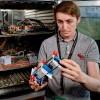William WHEELER defended his PhD on September 13th, 2023.
Place : Conference room of the Universitary Libray of University of Lyon
Jury :
Rapporteurs :
![]() M. BRIAT Olivier, Professeur des Universités, U. Bordeaux
M. BRIAT Olivier, Professeur des Universités, U. Bordeaux
![]() M. FORGEZ Christophe, Professeur des Universités, UTC
M. FORGEZ Christophe, Professeur des Universités, UTC
Examinateurs :
![]() Mme ALONSO Corinne, Professeure des Universités, U. Toulouse
Mme ALONSO Corinne, Professeure des Universités, U. Toulouse
![]() Mme HINAJE Melika, Professeure des Universités, U. Lorraine
Mme HINAJE Melika, Professeure des Universités, U. Lorraine
![]() Mme RAULET Marie-Ange, Maître de Conférences, UCB Lyon 1
Mme RAULET Marie-Ange, Maître de Conférences, UCB Lyon 1
Invités:
![]() M. MENIERE Frederic, Président, EVE System
M. MENIERE Frederic, Président, EVE System
![]() M. PELISSIER Serge, Directeur de Recherche, UGE
M. PELISSIER Serge, Directeur de Recherche, UGE
![]() M. RIVIERE Elie, Docteur Ingénieur R&D, EVE System
M. RIVIERE Elie, Docteur Ingénieur R&D, EVE System
Encadrement :
![]() M. SARI Ali, Professeur des Universités, UCB Lyon 1
M. SARI Ali, Professeur des Universités, UCB Lyon 1
![]() M. BULTEL Yann, Professeur des Universités, UGA , co-directeur de thèse
M. BULTEL Yann, Professeur des Universités, UGA , co-directeur de thèse
![]() M. VENET Pascal, Professeur des Universités, UCB Lyon 1, co-directeur de thèse
M. VENET Pascal, Professeur des Universités, UCB Lyon 1, co-directeur de thèse
Abstract :
 The reuse of batteries from electric vehicles is a major challenge to extend the life of these devices, limit their environmental impact, reduce their recycling cost and improve their economic value. However, reuse is not without risk. Numerous hazards can jeopardize reuse: unpredictable aging, inhomogeneity of aging, complex disassembly and selection process, safety defects... The aim of this work is the diagnosis and prognosis of the remaining useful life of lithium-ion batteries in order to determine the possibility of reuse in a second life. The study concerns lithium-iron-phosphate/graphite cells. An experiment aged fresh cells from new to advanced states of aging, up to 30% of state of health in some cases. Tests at equivalent states of health are uncommon in the literature. This data shows a non-linear aging between the first and second life. The understanding of the aging phenomena is therefore necessary before establishing a diagnosis and the prognosis of the cell’s health status. The postmortem study shows an inhomogeneous aging of the cell: the negative electrode undergoes a heterogeneous degradation on the surface. Functional areas have a degradation of their electrical characteristics. The positive electrode keeps similar characteristics before and after aging. The proposed health diagnosis method allows associating the loss of cell capacity to different aging modes: loss of lithium inventory and loss of active material at the negative electrode. The method is based on the analysis of the cell voltage by differential voltage analysis (DVA) and incremental capacity analysis (ICA). The method uses the pick tracking technique. At the end of this diagnostic work, ageing laws are formulated for the ageing of the negative electrode and the loss of lithium inventory. Finally, the prognosis of cell aging is given on the basis of these two aging laws. The remaining useful life is then estimated.
The reuse of batteries from electric vehicles is a major challenge to extend the life of these devices, limit their environmental impact, reduce their recycling cost and improve their economic value. However, reuse is not without risk. Numerous hazards can jeopardize reuse: unpredictable aging, inhomogeneity of aging, complex disassembly and selection process, safety defects... The aim of this work is the diagnosis and prognosis of the remaining useful life of lithium-ion batteries in order to determine the possibility of reuse in a second life. The study concerns lithium-iron-phosphate/graphite cells. An experiment aged fresh cells from new to advanced states of aging, up to 30% of state of health in some cases. Tests at equivalent states of health are uncommon in the literature. This data shows a non-linear aging between the first and second life. The understanding of the aging phenomena is therefore necessary before establishing a diagnosis and the prognosis of the cell’s health status. The postmortem study shows an inhomogeneous aging of the cell: the negative electrode undergoes a heterogeneous degradation on the surface. Functional areas have a degradation of their electrical characteristics. The positive electrode keeps similar characteristics before and after aging. The proposed health diagnosis method allows associating the loss of cell capacity to different aging modes: loss of lithium inventory and loss of active material at the negative electrode. The method is based on the analysis of the cell voltage by differential voltage analysis (DVA) and incremental capacity analysis (ICA). The method uses the pick tracking technique. At the end of this diagnostic work, ageing laws are formulated for the ageing of the negative electrode and the loss of lithium inventory. Finally, the prognosis of cell aging is given on the basis of these two aging laws. The remaining useful life is then estimated.
Keywords: Lithium-ion battery; Electric vehicle; State of Health; SoH; Differential Voltage Analysis; DVA; Incremental Capacity Analysis; ICA; Diagnosis; Prognosis; Remaining Useful Life; RUL; Accelerated aging; Lithium Iron Phosphate; Graphite; LFP; Graphite/LFP




